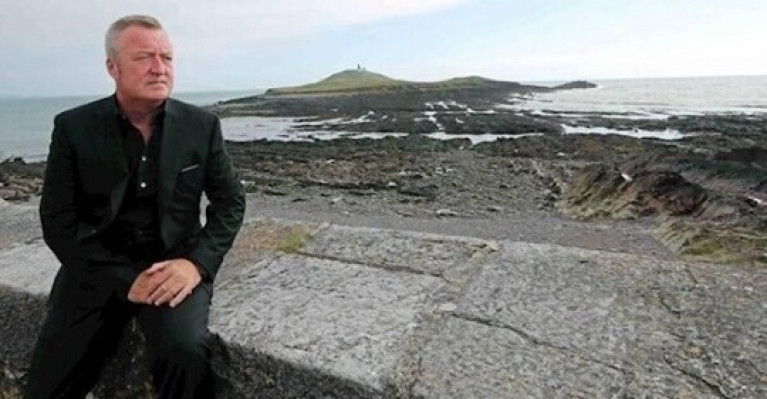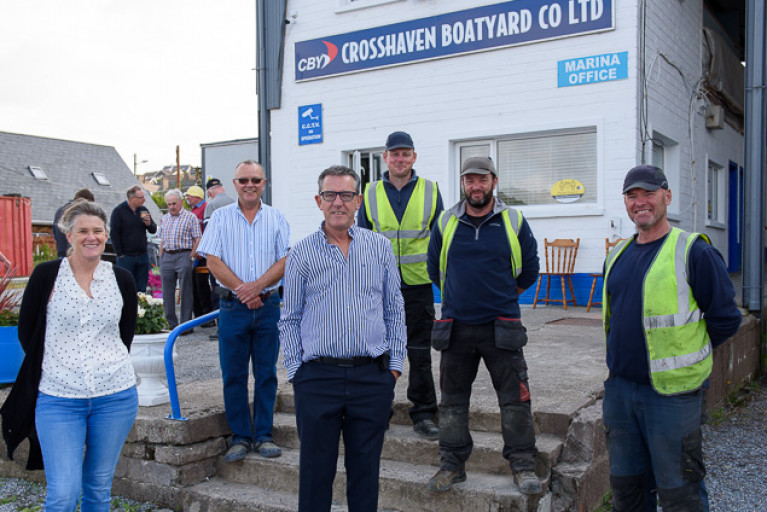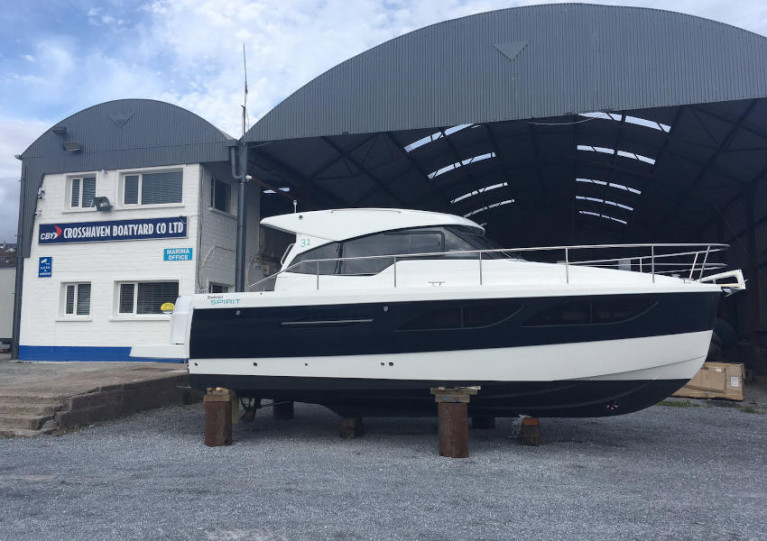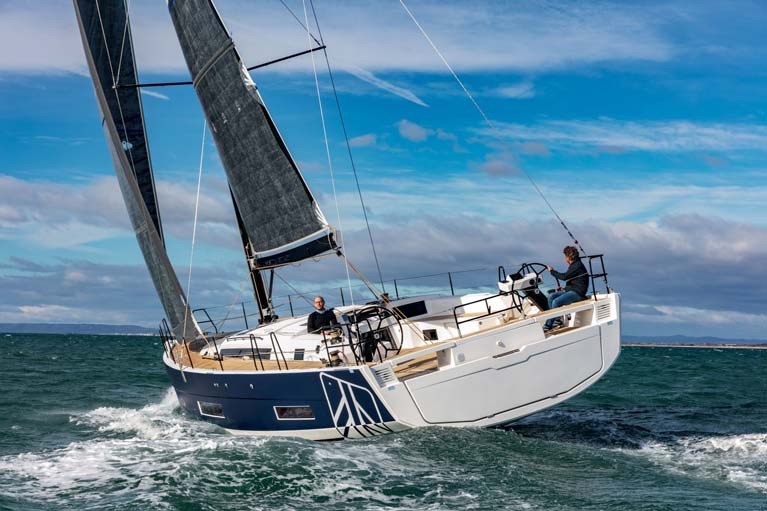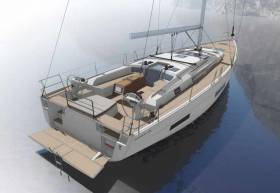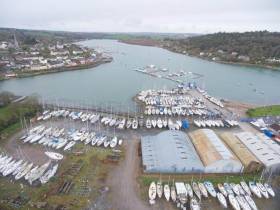Displaying items by tag: Crosshaven Boatyard
Green Rebel Marine & Fisheries Liaisons Announce Offshore Windfarm Communications Plan
Green Rebel Marine, the Cork-based business established to service the future needs of offshore wind farms, has announced a new strategic partnership with Fisheries Liaisons Ltd. The partnership is seen as being a key factor in communicating with the wider marine and fishing community as development of offshore wind farms picks up pace.
Fisheries Liaisons Ltd has been a strong supporter of fishing communities across the island of Ireland in their dealings with other off-shore operators. The company has a strong reputation for engagement with communities fishing in Irish coastal waters ahead of the arrival of new entrants to the offshore market.
The relationship between Fisheries Liaisons Limited and Green Rebel Marine is designed to ensure coastal communities are consulted with in advance of any work, and fully informed of the latest developments involving wind farm operations.
Plans for offshore wind farms are at an advanced stage with a number of potential fixed and floating operators examining sites along the coast from Dundalk in County Louth, to the Cork coast and beyond. Their construction will not only increase Ireland’s ability to produce renewable energy, it will also create an entire new sector dedicated to servicing their operation.
Pearse Flynn of Green Rebel Marine says, “Having come from a fishing community, I really appreciate the importance of the industry to livelihoods around the coast. The roll out of offshore wind will cross with the fishing industry at a number of points, and this new relationship with Fisheries Liaisons Ltd will mean that fishermen and their representatives organisations will be kept in the loop at all times. We aim to create a one-stop-shop between the fishing sector, their communities and the energy companies looking to place wind farms in Irish territorial waters. This new sector will create jobs and secure the future of our coastal communities.”
Fisheries Liaison Limited has three full-time staff, who will be based from the headquarters of Green Rebel Marine in Crosshaven, Co Cork. Since its creation, Fishery Liaisons has built a solid reputation conducting site specific risk analysis for a wide array of marine projects. In recent years, the company has evolved into the main stakeholder engagement partner for offshore wind project developers and the fishing community at large.
The team, all stemming from strong fishing heritage, apply decades of offshore and fishing liaison experience, to facilitate clear and transparent dialogue between the project developers and the fishing communities. Fishery Liaisons strive to develop good communication between the developers and the fishing communities, enabling them to co-exist throughout the project lifecycle. This collaboration with Green Rebel Marine will enable the team to continue to grow its expertise and expand its service offering well into the future.
Mark O’Reilly of Fisheries Liaisons Ltd says, “This is an opportunity for us to grow our team and provide a better service to the stakeholders concerned with this developing industry. We can now expand our presence on the ground and provide even more efficient support. Joining forces with Green Rebel Marine provides the platform we need to safeguard our fishing communities whilst enabling the development of offshore renewable energy towards a greener future for all. With energy companies now looking to place infrastructure at sea, we need to ensure that there is advance engagement at every turn, and that the fishing communities know they can rely on us to both listen and to convey their opinions in a timely and meaningful way.”
The British flagged Research/Survey Vessel Bibby Athena is a new visitor at Crosshaven Boatyard in Cork Harbour.
The catamaran is used for Seabed mapping and coastal survey work.
The 2014-built specialist ship has a length overall (LOA) of 27.5 metres and a width of 10.05 metres.
As part of its equipment, the Bibby Athena has onboard a d`ROP© survey ROV designed for shallow water survey and inspection, combining positioning from the DP vessel and a bespoke LARS system to maintain a fixed distance from the seabed.
Crosshaven Boatyard made the news last month when the extensive marine facility changed hands.
Its new owner Pearse Flynn (see Afloat's report 28-09-20 here) has revealed further details of how the extensive facility in Cork Harbour will fit into his plans to provide comprehensive shoreside and on-water services for offshore wind farms off the Cork Coast, some as far as 70 miles at sea.
Crosshaven Boatyard's new owner Pearse Flynn (see Afloat's report 28-09-20 here) has revealed further details of how the extensive facility in Cork Harbour will fit into his plans to provide comprehensive shoreside and on-water services for offshore wind farms off the Cork Coast, some as far as 70 miles at sea.
The yard, famed as the birthplace of Sir Francis Chichester's Gypsy Moth V in 1970, Tim Severin's ocean-voyaging "super-currach" St Brendan in 1977, and Denis Doyle's legendary offshore racer, the Frers 51 Moonduster, in 1981 - in addition to many other internationally-noted craft - is expected to be retaining many of its basic leisure boating services, while providing new work in the supply chain to the offshore wind industry.
Originally from Ballycotton in East Cork, Pearse Flynn (57) has had a remarkable international career, both as a senior executive in large corporations with a global reach, and as an entrepreneur. But according to an interview with Ian Guider in yesterday's Business Post, his heart has always remained in Ballycotton. And having one of his two homes there, he is keen to develop the vitality and economic clout of the small south coast ports, while retaining their strong sense of community.
Thus he feels that a highly-skilled locally-based workforce could be created by dynamic interaction with the growing wind energy industry. He reckons that if the ports such as Ballycotton and Crosshaven cannot provide the special combination of skills and service vessels, then his personal experience of working with the big international corporations involved leaves him in no doubt that they will readily import what they need from wherever it is easily available, depriving the small Irish ports of potentially significant sources of structural income and local employment.
 Busy man back home – international entrepreneur Pearse Flynn in Ballycotton. Photo courtesy: Irish Examiner
Busy man back home – international entrepreneur Pearse Flynn in Ballycotton. Photo courtesy: Irish Examiner
Thus he has invested €10 million in buying the boatyard – which comes with nine acres in a mix of workshops, covered storage and boat building facilities, in addition to extensive outdoor boat storage – and in ordering two special service vessels.
As to the actual wind farms, one line of approach which the team in his company Green Rebel Marine is researching is the possibility of turbines on floating platforms. But as of now, the village of Crosshaven is getting used to the idea that some truly cutting-edge sea-going technology may well be developed in a special place where traditional and modern boat-building have successfully inter-acted for many years.
€10m Investment for Green Energy Project in Cork Harbour
Irish businessman Pearse Flynn who made his fortune in the tech and telecoms has announced a €10m investment in a green energy project in Cork Harbour that aims to create 80 jobs within two years.
Flynn has acquired Crosshaven Boatyard as the headquarters of his new venture, Green Rebel Marine, to service the future needs of offshore windfarms.
The firm will use the nine-acre site as its base for surveying, equipping and servicing a network of planned wind farms along the Irish coast. The boatyard will continue its normal operations as a boatyard.
Mr Flynn, who is originally from East Cork and who owns and heads up UK debt solution company Creditfix, has also bought two specially equipped hi-tech ships for the new business.
The first vessel – the Bibby Athena, which will be renamed Roman Rebel - has already arrived in Cork. The second is scheduled to arrive later this year.
For further reading from the Irish Examiner here.
Matt Foley Retires from Crosshaven Boatyard After Forty Years Service
After forty years of service, popular County Cork boatyard manager Matt Foley has retired from Crosshaven Boatyard.
Matt started work in the Cork Harbour yard on the 20th of August 1980. His first role was as a storeman at a very busy time with famous yachts such as the Frers 50, 'Moonduster' and 'Golden Apple' both in build at the yard. Also back then – which many consider the yard's heyday – 40-foot trawlers were also built on-site, presenting an often hectic but happy scene for Matt and the Crosshaven team.
Over the years, Matt, who continues to play an active role as Treasurer in the Crosshaven RNLI Lifeboat since the stationed opened in 2000, was often multi-tasking and took on varied roles as the boatyard changed focus, including operating the Travel Hoist hauling and launching boats, all done in his usual affable and professional manner.
In March 2005, Matt was invited to take on the role of Boatyard Manager and Company Secretary which he did so reluctantly at first as it was his first managerial role. However, like everything else in the yard, Matt took to the new position quickly and soon earned the respect of both customers and staff alike.
In an overall context, Matt is credited with helping to turn the Boatyard into a profitable business. He also played a key role at the yard in supporting Cork Week Regatta at its height and more recently rebuilding the Boatyard's 120-berth Marina in 2014.
Yacht broker Donal McClement who worked in association with the yard describes Matt as "firm but fair and always a pleasure to work with". Matt's colleague Hugh Mockler, the yard's current broker, has been one of the first to wish Matt well into the future. "Everyone in Crosshaven Boatyard says it was a privilege to work with Matt and we wish him and his wife Jackie a very happy retirement".
Irish Marine Federation Chairman Paal Janson has also wished Matt "a happy retirement" and extends the "appreciation and good wishes of the Irish marine industry for his long service".
Crosshaven Boatyard Unwraps New Rodman Spirit 31
Crosshaven Boatyard — the Irish agents for Rodman Boats — yesterday took the wrapping off a new Rodman Spirit 31 at their Cork Harbour yard and marina.
The hardtop inboard model comes with 320HP Volvo diesel engine, slightly different from the one that was shown with the Spanish brand’s latest range at boot Düsseldorf earlier this year.
For more details, contact Crosshaven Boatyard at 021 483 1161 or email [email protected]
New #Rodman #Spirit 31 with a 320HP #Volvo diesel unwrapped today in #Crosshaven #Boatyard Thank you Rodman ?? for your quality #boat ?? with @RodmanBoats @RBSMARINE @AfloatMagazine pic.twitter.com/4CN5MZQxqY
— Crosshaven Boatyard (@CrosshavenBY) July 14, 2020
French yacht builder Dufour has launched a ‘virtual marina’ where customers can visit the brand’s models at a safe distance, and in the comfort of their own homes.
“In this springtime period when everyone should be able to sail and go to boat shows, the priority today is to stay at home,” said the company based near La Rochelle.
“Our departments are also protected and they are already preparing with all our partners the return to full activity and stay with you.
“In this expectation, we have designed this virtual marina to visit all the Dufour yachts while staying at home. It’s the best way for us to continue to inspire you, to make you dream, and to share our common passion.”
The Dufour website hosts the virtual guided tour not unlike the real-life experience, where you can ‘walk’ along a CGI jetty and explore the full range of boats, inside and out.
And Dufour’s Irish dealers at Crosshaven Boatyard have welcomed the initiative, with broker Hugh Mockler saying: “No matter where in the world you are, we all love to walk the marinas to admire what’s on offer. Dufour’s new virtual marina offers you just that.
“Just follow what looks like a yellow brick road and click on the yellow spot. This will then bring you on board each yacht to have a nose. It really is very clever and brings us into a dream for the future.”
Hugh added: “Our hearts go out to all the people that have suffered and are suffering during this awful time. We all look forward to a better and kinder future.”
The New Dufour 530: Three Boats in One
The new Dufour 530 is an exciting new departure for Dufour Yachts. She comes in three different variations, which covers every aspect of sailing for a boat of this size writes Irish agent Hugh Mockler of Crosshaven Boatyard.
The “Easy” version is suitable for the sailor or the Charter Company that want to keep sailing simple. Her coachroof is clear of any obstructions with control lines coming back to the two winches at the helm.
The “Ocean” version is suitable for the “traditional” sailor who likes to do a bit of tweaking. This version is presented more like the old “Grand Large” range with winches on the coachroof and at the helm and the mainsail traveller on the roof instead of pad eyes.
The “Performance” version is what it says on the tin. It is for the sailor who wants more performance, likes to do a lot of tweaking and also likes to do a bit of racing around the cans.
 The Dufour 530 performance version
The Dufour 530 performance version
Like her sisters in the former “Performance” range, her mainsail sheet is located in the cockpit, more winches, hydraulic backstays and boom vang. She also comes with upgraded mast and boom for an increased sail area of 20 m2. and her 2.80-metre keel comes complete with a lead bulb.
The new Dufour 530 is really three boats in one, she looks very smart and can be tailored to suit your needs.
More information on the new model here including a unique online tool to view the design right from your desktop.
The New Dufour 530 – a New Vision & Three New Models to Debut at Boot Düsseldorf 2020
Hot on the heels of the highly successful Dufour 390 and 430, Irish Dufour Yachts agents Crosshaven Boatyard have announced the launch of the new Dufour 530.
This latest new model demonstrates the investment and confidence in the brand, which is going from strength to strength.
Making her World debut at Boot Düsseldorf, the 530 is a merger of Dufour’s Grand Large and Performance ranges. A key difference is this yacht is available in three versions with distinctly different deck layouts.
The 530 ‘Easy’ model, as the name suggests, is the most simplified version, perfectly set up for owners wanting simple and straight forwards cruising. With a clean, uncluttered cabin roof layout, and control of all the lines which are led directly back to the helm, she will certainly be ‘easy’ to handle.
The 530 ‘Ocean’ model is specifically for owners seeking a traditional deck layout. The halyards are led to the aft cockpit/helm position, along with two additional winches for genoa and mainsheet control. A noticeably wide, full-width mainsheet traveller is positioned on the coach roof for enhanced mainsail trimming.
The 530 ‘Performance’ model is an evolution of the much-loved Performance Range. Aimed at owners wishing to race competitively, as well as maximise their cruising experience. The 530 Performance features an upgraded mast and boom package, an increased sail area of 20m2, additional winches, a 2.80m lead keel, plus a fully upgraded hydraulic package to safely control the increased loads.
The long and successful relationship with the renowned Felci Yacht design team sees many familiar features from previous Grand Large models included on the new 530. Together with the evolution of new ideas and opportunities from a completely new hull and deck design.
The now-familiar and impressive bow volumes have been adapted to maximise the available space forwards below decks. Extending the hull chines aft also offers enhanced performance and sailing comfort, as well as creating volumes of extra space, both above and below decks aft and in the cockpit area. An optional sunbed can be fitted in the large, spacious cockpit between the two helm stations, an idea borrowed from the Dufour 63.
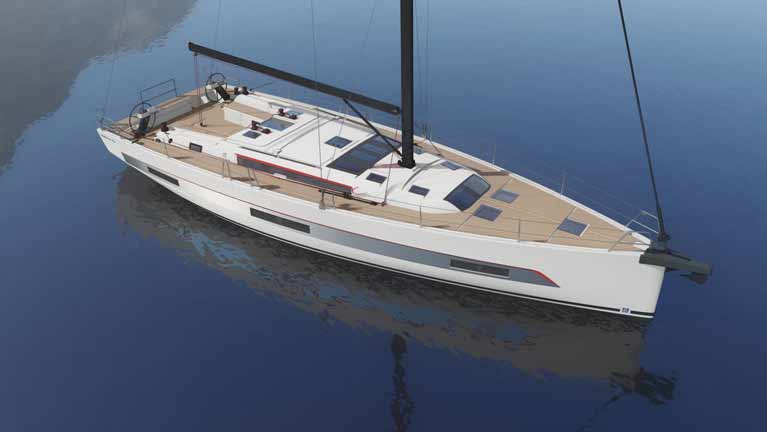 Dufour 530 Performance
Dufour 530 Performance
The aft transom area has been designed to include two access points into the cockpit from the bathing platform. Either side of the now ‘trademark’ Dufour BBQ and external galley, is the option to include retractable dinghy davits. There is ample, easily accessible stowage for vital safety equipment and a liferaft, and the whole cockpit can be covered by a semi-permanent bimini. The new cockpit design includes a step up for secure and easy access to the wide side decks and there’s specific storage areas for all the sheets and halyards.
The area below the transom has been engineered to enhance access to technical equipment and systems, both through a hatch in the cockpit floor and via hatches in the transom to make inspection and maintenance easy.
At 16.35m length overall, she has a waterline length just under 15m to enhance speed through the water. With a maximum beam of just under 5m, the Dufour 530 offers spacious living areas and accommodation. With a large forward galley, the saloon space is typical of the Dufour DNA, roomy, airy and with lots of natural daylight. Cabin layouts range between three cabins and three heads/showers up to six cabins, with double pullman cabins and three heads/showers. Up front there is a choice of a large forward owner’s cabin or twin double cabins for charter work, and aft the cabin layouts offer one double and one twin. Each model is available with a skipper’s cabin.
Base price: €300,700 ex VAT. Options and extras available on request. More from Hugh Mockler at Crosshaven Boatyard here
Crosshaven Boatyard For Sale As Going Concern Only, Manager Confirms
#CorkHarbour - Crosshaven Boatyard manager Matt Foley has confirmed to Afloat.ie that the Cork Harbour facility is for sale as a going concern only, and not with vacant possession as advertised by the auctioneers and in the Irish Examiner.
Foley says that Cushman & Wakefield, the appointed auctioneers, have been instructed to remove the vacant possession section from their advertisement.
Earlier this year, Afloat.ie reported on plans by Doyle Shipping Group to offer Crosshaven Boatyard for sale as it concentrates its core stevedoring business in Dublin, Cork and elsewhere.





























